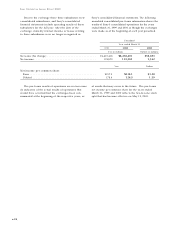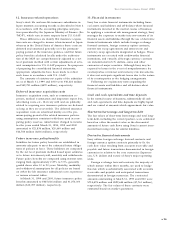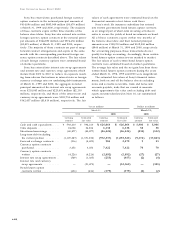Sony 2000 Annual Report Download - page 72
Download and view the complete annual report
Please find page 72 of the 2000 Sony annual report below. You can navigate through the pages in the report by either clicking on the pages listed below, or by using the keyword search tool below to find specific information within the annual report.
70
SONY CORPORATION ANNUAL REPORT 2000
Advertising cost
Except for advertising costs for film product, insurance
policies and direct-response advertising, Sony expenses
the production costs of advertising the first time the ad-
vertising takes place. Advertising costs for film product
are capitalized and amortized over the related revenue
streams in each market that such costs are intended to
benefit in accordance with Financial Accounting Standards
Board (“FASB”) Statement No. 53, “Financial Reporting
by Producers and Distributors of Motion Picture Films”.
Advertising costs for acquiring new insurance policies
are deferred and amortized as part of the insurance
acquisition costs. Direct-response advertising costs are
capitalized and amortized over its expected period of
future benefits.
Income taxes
The provision for income taxes is computed based on
the pretax income included in the consolidated state-
ments of income. The asset and liability approach is
used to recognize deferred tax assets and liabilities for
the expected future tax consequences of temporary
differences between the carrying amounts and the tax
bases of assets and liabilities.
Derivative financial instruments
Derivative financial instruments, which include foreign
exchange forward contracts, foreign currency option
contracts, interest rate swap agreements, and interest
rate and currency swap agreements, are used in Sony’s
risk management of foreign currency and interest rate
risk exposures of its financial assets and liabilities.
Foreign exchange forward contracts
Sony enters into foreign exchange forward contracts
to limit exposure, affected by changes in foreign
currency exchange rates, on accounts receivable and
payable and cash flows generated from anticipated
transactions denominated in foreign currencies.
Foreign exchange forward contracts which are
designated and effective as hedges of such currency
exchange rate risk on existing assets and liabilities
are marked to market and included as an offset to
foreign exchange gains/losses recorded on the exist-
ing assets and liabilities. Such contracts on anticipated
transactions, including contracts used to hedge inter-
company foreign currency commitments, which do
not qualify as firm commitments, are marked to
market with changes in value recognized in foreign
exchange gains/losses.
Foreign currency option contracts
Sony enters into purchased foreign currency option
contracts to limit exposure, affected by changes in
foreign currency exchange rates, on cash flows gen-
erated from anticipated transactions denominated in
foreign currencies. Sony also enters into written for-
eign currency option contracts, of which the majority
are part of range forward contracts corresponding to
the purchased foreign currency option contracts. In
addition to the range forward contracts, Sony enters
into written foreign currency option contracts to
minimize its hedging costs. The carrying values of
all foreign currency option contracts are marked to
market with changes in value recognized in foreign
exchange gains/losses.
Interest rate swap agreements and interest rate
and currency swap agreements
Sony enters into interest rate swap agreements or
interest rate and currency swap agreements in order
to lower funding costs, to diversify sources of fund-
ing and to limit Sony’s exposure in relation to under-
lying debt instruments resulting from adverse
fluctuations in interest rates or foreign currency ex-
change rates. The related interest differentials paid or
received under the interest rate swap agreements
and under the interest rate and currency swap agree-
ments are recognized over the terms of the agree-
ments in interest expense. Currency swap portions of
the interest rate and currency swap agreements
which are designated and effective as hedges of
exposure resulting from changes in foreign currency
exchange rates on underlying debt denominated in
foreign currency are marked to market and included
as an offset to foreign exchange gains/losses on the
underlying debt.
After an underlying hedged transaction is settled or
ceases to exist, all changes in fair value of related
derivatives which have not been settled are recognized
in foreign exchange gains/losses.
Stock-based compensation
In accordance with Accounting Principles Board
Opinion (“APB”) No. 25, “Accounting for Stock Issued
to Employees”, stock-based compensation cost is
recognized in income based on the excess, if any, of
the quoted market price of the stock at the grant date of
the award or other measurement date over the stated
exercise price of the award.
Free distribution of common stock
On occasion, Sony Corporation may make a free distri-
bution of common stock which is accounted for either
by a transfer of the applicable par value from additional
paid-in capital to the common stock account or with no
entry if free shares are distributed from the portion of
previously issued shares accounted for as excess of par
value in the common stock account.
Under Japanese Commercial Code, a stock dividend
can be effected by an appropriation of retained earnings
to the common stock account by resolution of the
General Shareholders’ Meeting, followed by a free share
























